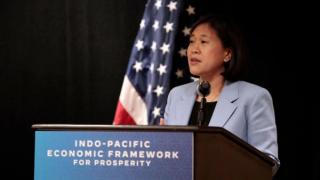Launched in May 2022, the Indo-Pacific Economic Framework (IPEF) is an initiative among 14 member countries, including the United States and Australia, to establish common approaches to diverse regional economic issues.
Following the US withdrawal from the Trans-Pacific Partnership (TPP) in 2017, IPEF was designed to keep the United States engaged in regional economic discussions without committing the United States to the sort of trade negotiations that entailed the more contentious topic of reducing trade barriers.
IPEF has been controversial in the region due to its lack of more conventional trade incentives, such as tariff reductions (known as market access), which are a key aspiration for many IPEF members. Instead, members have pledged to coordinate their approaches to four economic issues (called IPEF pillars): trade (including digital), supply chains, clean energy and tax and anti-corruption.
Why are supply chains important to IPEF nations?
The supply chain pillar is the first to reach a “substantial conclusion” of negotiations, with IPEF members announcing the proposal of an IPEF Supply Chain Agreement on 27 May 2023. A substantial conclusion is not a definitive agreement that all members have signed, but it is a milestone on the way to one.
The COVID-19 pandemic and growing geopolitical tensions have led to increased recognition of both traditional and strategic disruption risks to global supply chains. Many IPEF partners are looking to build resiliency into their supply chains through diversification (such as sourcing goods from a larger variety of countries or producing goods domestically). The fact that negotiations over IPEF’s supply chain pillar were the first to conclude indicates both the importance and greater consensus on this issue among partners — even over trade, climate and governance.
One of the Biden administration’s major foreign policy objectives has been to improve supply chain security. For the United States, the hope is that IPEF will help to establish new supply chains that diversify away from Chinese monopolies on the production of certain critical goods, but it has been unwilling to pursue free trade agreements to diversify its sources, instead focusing on domestic onshoring policies. Including market access in IPEF could improve its members’ supply chain resiliency by facilitating trade flows and making it easier to source inputs or workers from alternate sources during a supply chain shock. For example, the United States could use IPEF to expand its critical minerals partnerships (as it has done with Japan and Australia) to diversify its sources of critical minerals and build resiliency into its EV supply chain. However, due to a changed domestic political landscape in recent years, traditional market access like the TPP is unlikely to be on the negotiating table in the short term.
How has IPEF been tracking and what are the recent developments?
Under the proposed agreement, IPEF nations committed to collaborate on increasing the “resilience, efficiency, productivity, sustainability, transparency, diversification, security, fairness, and inclusivity” of their supply chains, a broad and ambitious statement, but vague on tangible actions or specific supply chains. Essentially, it means IPEF partners will cooperate on monitoring their supply chains (e.g. by providing training on monitoring), preventing bottlenecks (such as by investing in critical sectors and ensuring a pipeline of skilled workers) and addressing crises (e.g. by delivering goods to the affected member). However, because IPEF doesn’t constitute a free trade agreement, these commitments will not be enshrined in law, or enforceable.
IPEF members agreed to contemplate three new bodies, but have yet to officially agree to establish them:
- The IPEF Supply Chain Council, where countries will develop sector-specific action plans for critical sectors, diversify their sources, facilitate joint R&D and develop the necessary infrastructure and workforce. Many IPEF members have crafted their own supply chain policies for critical sectors, but this would be the first coordinated plan across the Indo-Pacific.
- The Supply Chain Crisis Response Network, an emergency communications channel where members can seek timely support during a supply chain disruption. This is similar to an initiative the United States launched with the EU to create an early warning system on semiconductor supply chains disruptions.
- A Labour Rights Advisory Board, which aims to promote labour rights across supply chains. Labour rights have been a key issue of the Biden administration, hence its inclusion in IPEF, which some low and middle-income members have been more hesitant to support.
While there has been no public announcement of new funding to implement the proposed agreement, some members have made separate related commitments. Australia and South Korea announced an initiative to boost the capacity of other IPEF partners to monitor and manage supply chain vulnerabilities. The United States proposed several initiatives, including trade missions between IPEF members, and establishing Mutual Recognition Agreements (where testing of goods takes place in the exporting country, rather than the destination country, enabling quicker and easier trade flows).
What are the next steps for finalising and implementing the agreement?
IPEF members haven’t indicated when their proposed supply chain initiatives will go into effect. What we know is that early IPEF negotiations for the other pillars are expected to progress by the end of 2023, in time for the US hosting of the Asia-Pacific Economic Cooperation (APEC) forum in November. The next round of negotiations is expected to be held in early July in Busan, South Korea.
Regarding this most recent supply chains development, IPEF members will return home to seek domestic approval, and then develop a full text agreement. If the agreement is ratified, the questions raised will be how the agreed initiatives will be implemented and how effective they will actually be.






